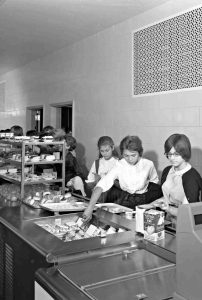A Brief History of School Meals
The National School Lunch Program, signed into law in 1946, aimed to address two problems: childhood hunger and surplus commodities. Farm products that had no other market would now go into school lunches for low-income children.
Since then, the program has evolved to reflect the concerns of its time. In the 1970s, Congress dramatically expanded it, after activism from groups such as the Black Panthers focused public attention on the connection between nutrition and learning. The following decade, the federal government slashed school lunch funding while famously declaring that ketchup was a vegetable. As childhood obesity has increased, the program has sharpened its focus on nutrition. Today, school cafeterias are required to serve more fruits and vegetables and fewer fats.
Baltimore City Public Schools’ food program has grown along with the national program. By 1970, students in every school in the city had access to free or reduced-cost lunches. Since 2015, Baltimore has exceeded federal requirements, offering free breakfast and lunch to all Baltimore students regardless of family income.



